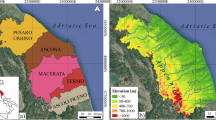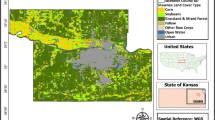Abstract
Remote sensing from satellites is the only means to obtain land surface temperature (LST) and emissivity on a larger scale. LST has many applications, e.g., in radiation budget experiments and global warming, and desertification studies. Over the last decades, substantial amount of research was dedicated towards extracting LST and emissivity from surface-leaving radiance and de-coupling the two from each other. This paper provides the physical basis, discusses theoretical limitations, and gives an overview of the current methods for space-borne passive sensors operating in the infrared range, e.g., NOAA-AVHRR, Meteosat, ERS-ATSR, TERRA-MODIS, and TERRA-ASTER. Atmospheric effects on estimated LST are described and atmospheric-correction using a radiative transfer model (RTM) is explained. The methods discussed are the single channel method, the split window techniques (SWTs), and the multi-angle method.
Similar content being viewed by others
References
Becker, F. and Li, Z-L. (1990a). Towards a local split. window method over land surface. Int. J. Remote Sensing,11: 369–394.
Becker, F. and Li, Z-L. (1990b). Temperature-Independent spectral indices in thermal infrared bands. Remote Sensing Env.,32: 17–33.
Becker, F. and Li, Z.-L. (1995). Surface temperature and emissivity at different scales: definition, measurement and related problems. Remote Sensing Reviews,12: 225–253.
Chedin, A., Scott, N. and Berroir, A. (1982). A single-channel double viewing method for SST determination from coincident Meteosat and TIROS-N measurements. J. Applied Meteorology.21: 613–618.
Dash, P., Göttsche, F-M., Olesen, F-S. and Fischer, H. (2001). Land surface temperature and emissivity estimation from passive sensor data: theory and practice; current trends. Int. J. Remote Sensing (in press).
Franca, G. B. and Cracknell, A. P. (1994). Retrieval of land and sea surface temperature using NOAA-11 AVHRR data in north-eastern Brazil. Int. J. Remote Sensing,15: 1695–1712.
Gillespie, A.R., Rokugawa, S., Hook, S.J., Matsunaga, T. and Kahle, A.B. (1996). Temperature/emissivity separation algorithm theoretical basis document. Version 2.3., NAS5-31372, NASA/GSFC. Greenbelt MD, USA.
Göttsche, F.-M. and Olesen, F-S. (2001). Modelling of diurnal cycles of brightness temperature extracted from METEOSAT data, Remote Sensing Env.,76: 338–349.
Herrera, F., Rosa, F., Gonzalez, A. and Pérez, J. C. (1999). Method based on a radiative transfer model to extract the solar component from NOAA-AVHRR channel-3. Int. J. Remote Sensing,20: 699–710.
Ignatov, A. M. and Dergileva, I. L. (1994). Angular effect in dual-window AVHRR brightness temperatures over oceans. Int. J. Remote Sensing,15: 3845–3850.
Kahle, A. B., Madura, D. P. and Soha, J. M. (1980). Middle infrared multispectral aircraft scanner data: analysis for geological applications. Appl. Optics,19: 2279–2290.
Kealy, P. S. and Hook, S. J. (1993). Separating temperature and emissivity in thermal infrared multispectral scanner data: Implications for recovering land surface temperatures, IEEE Transactions on Geoscience and Remote Sensing,31(6): 1155–1164.
Kerr, Y. H., Lagouarade, J. P. and Imbernon, J. (1992). Accurate land surface temperature retrieval from AVHRR data with use of an improved split window algorithm. Remote Sensing Env.,41: 197–209.
Kidder, S. Q. and Vonder Haar,T. H. (1995). Satellite Meteorology: an introduction, 1st edn (London: Academic Press).
Kneizys, F.X., Robertson, D.C., Abreu, L.W., Acharya, P., Anderson, G.P., Rothman, L.S., Chetwynd, J.H., Sleety, J. E. A., Shettle, E. P., Gallery, W. O., Berg, A., Clough, S.A., and Bernstein, L.S. Edited by: Abreu, L. W. and Anderson, G.P. (Jan. 11, 1996). The MODTRAN 2/3 Report and LOWTRAN 7 MODEL. Philipps Laboratory, Hanscom, USA.
Lakshmi, V. and Susskind, J. (2000). Comparison of TOVS-derived land surface variables with ground observations. J. Geophys. Research,105: 2179–2190.
Li, Z-L., Becker, F., Stoll, M. P. and Wan, Z. (1999). Evaluating six methods for extracting relative emissivity spectra from thermal infrared images. Remote Sensing Env.,69: 197–214
McMillin, L. M. (1975). Estimation of sea surface temperature from two infrared window measurements with different absorption. J. Geophys. Research,80: 5113–5117.
Nerry, F., Labed, J. and Stoll, M. P. (1988). Emissivity signatures in the thermal IR band for remote sensing: calibration procedure and method of measurements. Appl. Optics,27: 758–764.
Ottlé, C. and Vidal-Madjar, D. (1992). Estimation of land surface temperature with N0AA9 data. Remote Sensing Env.,40: 27–41.
Prata, A. J. (1993). Land surface temperatures derived from the advanced very high resolution radiometer and the Along-Track Scanning Radiometer 1. Theory. J. Geophys. Research,98: 16689–16702.
Prata, A. J., Caselles, V., Coll, C, Sobrino, A. and Ottlé, C. (1995). Thermal remote sensing of land surface temperature from satellites: current status and future prospects, Remote Sensing Reviews,12: 175–224.
Price, J. C. (1983). Estimation of surface temperatures from satellite thermal infrared data- a simple formulation for the atmospheric effect. Remote Sensing Env.,13: 353–361.
Price, J. C. (1984). Land surface temperature measurements from the split window channels of the NOAA-7 AVHRR. J. Geophy. Research,89: 7231–7237.
Qin, Z. and Karnieli, A. (1999). Progress in remote sensing of land surface temperature and ground emissivity using NOAA-AVHRR data. Int. J. Remote Sensing,20: 2367–2393.
Reutter, H., Olesen, F. S. and Fischer, H. (1994). Distribution of the brightness temperature of land surfaces determined from AVHRR data. Int. J. Remote Sensing,15: 95–104.
Salisbury, W. and D’Aria, D. M. (1992). Emissivity of terrestrial materials in the 8–14 mm atmospheric window. Remote Sensing Env.,42: 83–106.
Schädlich, S., F.-M. Göttsche and F.-S. Olesen (2001). Influence of land parameters and atmosphere on Meteosat brightness temperatures and generation of land surface temperature maps by temporally and spatially interpolating atmospheric correction. Remote Sensing Env.,75: 39–46.
Schroedter, M., Olesen, F. and Fischer, H. (2001). Determination of LST distributions from single channel IR measurements: An effective spatial interpolation method for the use of TOVS, ECMWF and radiosonde profiles in the atmospheric correction scheme. Int. J. Remote Sensing (in press).
Scorer, R. S. (1987). Cloud formations seen by satellite. Proceedings of NATO ASI on Remote Sensing Applications in Meteorology and Climatology, 17 Aug.-6 Sep. 1987 (Dundee, Scotland: NATO Series C: Mathematical and Physical Sciences),201: pp. 1–81.
Sobrino, J. A., Cool, C. and Caselles, V. (1991). Atmospheric correction for land surface temperature using NOAA-11 AVHRR channels 4 and 5. Remote Sensing Env.,38: 19–34.
Susskind, J., Rosenfield, J., Renter, D. and Chahine, M. T. (1984). Remote sensing of weather and climate parameters from HIRS2/Msu on TIROS-N. J. Geophys. Research,89: 4677–4697.
Valor, E. and Caselles, V. (1996). Mapping land surface emissivity from NDVI: Application to European, African, and South American areas. Remote Sensing Env.,57: 167–184.
Watson, K. (1992). Spectral ratio method for measuring emissivity. Remote Sensing Env.,42: 113–116.
Wilber, A. C, Kratz, D. P. and Gupta, S. K. (1999). Surface emissivity maps for use in satellite retrievals of longwave radiation. NASA Technical Publications, NASA/TP-1999-209362, NASA/LRC, Hampton Virginia, USA.
Author information
Authors and Affiliations
About this article
Cite this article
Dash, P., Göttsche, FM., Olesen, FS. et al. Retrieval of land surface temperature and emissivity from satellite data: Physics, theoretical limitations and current methods. J Indian Soc Remote Sens 29, 23–30 (2001). https://doi.org/10.1007/BF02989910
Received:
Revised:
Issue Date:
DOI: https://doi.org/10.1007/BF02989910




